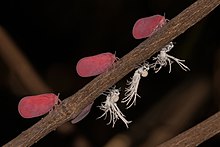Loading AI tools
Superfamily of insects From Wikipedia, the free encyclopedia
A planthopper is any insect in the infraorder Fulgoromorpha,[1] in the suborder Auchenorrhyncha,[2] a group exceeding 12,500 described species worldwide. The name comes from their remarkable resemblance to leaves and other plants of their environment and that they often "hop" for quick transportation in a similar way to that of grasshoppers. However, planthoppers generally walk very slowly. Distributed worldwide, all members of this group are plant-feeders, though few are considered pests. Fulgoromorphs are most reliably distinguished from the other Auchenorrhyncha by two features; the bifurcate (Y-shaped) anal vein in the forewing, and the thickened, three-segmented antennae, with a generally round or egg-shaped second segment (pedicel) that bears a fine filamentous arista.
| Planthopper Temporal range: | |
|---|---|
 | |
| Flatida rosea (Flatidae) adults and nymphs | |
| Scientific classification | |
| Domain: | Eukaryota |
| Kingdom: | Animalia |
| Phylum: | Arthropoda |
| Class: | Insecta |
| Order: | Hemiptera |
| Suborder: | Auchenorrhyncha |
| Infraorder: | Fulgoromorpha Evans, 1946 |
| Families | |
Planthoppers are laterally flattened and hold their broad wings vertically, in a tent-like fashion, concealing the sides of the body and part of the legs.[3] Nymphs of many planthoppers produce wax from special glands on the abdominal terga and other parts of the body. These are hydrophobic and help conceal the insects. Adult females of many families also produce wax which may be used to protect eggs.[4]

Planthopper nymphs also possess a biological gear mechanism at the base of the hind legs, which keeps the legs in synchrony when the insects jump. The gears, not present in the adults, were known for decades[5] before the recent description of their function.[6]
Planthoppers are often vectors for plant diseases, especially phytoplasmas which live in the phloem of plants and can be transmitted by planthoppers when feeding.[7]
A number of extinct planthopper taxa are known from the fossil record, such as the Lutetian-age Emiliana from the Green River Formation (Eocene) in Colorado.[8]
Both planthopper adults and nymphs feed by sucking sap from plants; in so doing, the nymphs produce copious quantities of honeydew, on which sooty mould often grows.[3] One species considered to be a pest is Haplaxius crudus, which is a vector for lethal yellowing, a palm disease that nearly killed off the Jamaican Tall coconut variety.[9]
The infraorder contains two superfamilies, Fulgoroidea and Delphacoidea. As mentioned under Auchenorrhyncha, some authors use the name Archaeorrhyncha as a replacement for the Fulgoromorpha.
Extinct families include:
Seamless Wikipedia browsing. On steroids.
Every time you click a link to Wikipedia, Wiktionary or Wikiquote in your browser's search results, it will show the modern Wikiwand interface.
Wikiwand extension is a five stars, simple, with minimum permission required to keep your browsing private, safe and transparent.